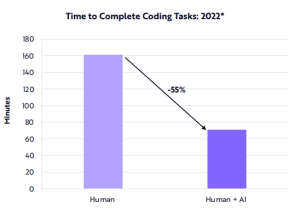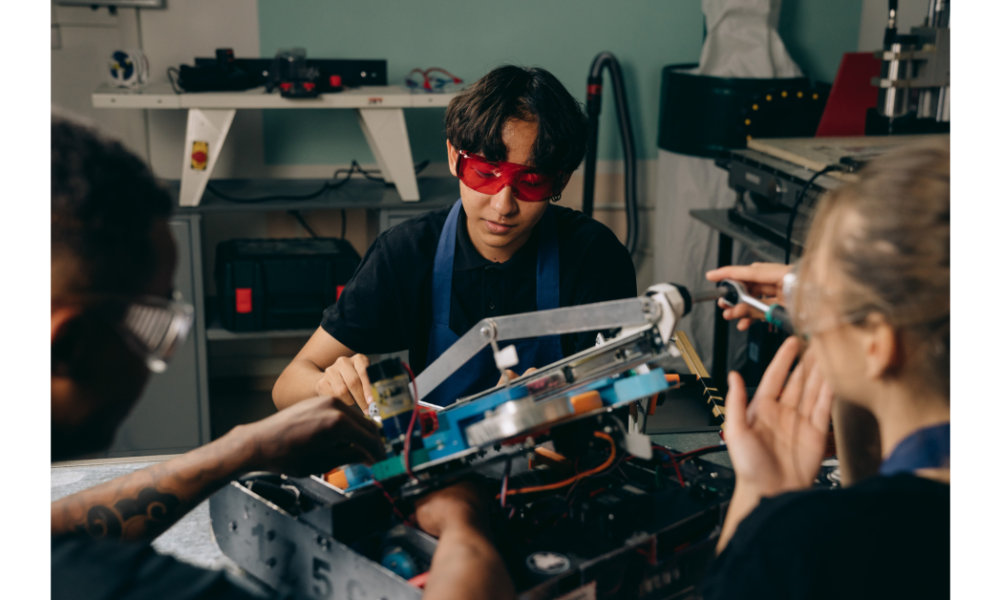
The latest unceasing and innovative technological advancements are led by domains like artificial intelligence (AI), robotics, blockchain, and programmable biology. These technologies are revolutionizing retail, automobile, finance, manufacturing, and many more industries on both, macro and micro levels.
AI, in particular generative AI, is transforming the lifestyles and day-to-day tasks of knowledge workers – individuals that are subject matter experts with formal education and training. Quite evident in professions such as programming, designing, engineering, and writing, generative AI has enhanced the productivity of knowledge workers.
But what is generative AI exactly and what makes it critical for knowledge workers? Let’s explore this idea more!
What is Generative AI?
Generative AI creates new content such as text, video, audio, and image automatically using AI algorithms, based on human-written prompts.
Some of the most prominent AI generation tools and products include:
- ChatGPT – Developed by OpenAI, ChatGPT is an intelligent AI chatbot capable of providing extremely detailed and personalized responses based on user prompts.
- DALL-E 2, Stable Diffusion, & Midjourney – These are AI-powered image generation tools.
- Meta – This is an AI-powered video generation tool that allows users to generate videos from textual prompts.
- Codex – It enables programmers to generate code in several programming languages within a few seconds.
Now, let’s see how generative AI affects knowledge workers!
Understanding How Generative AI Increases the Productivity of Knowledge Workers From Different Domains
According to ARK’s Big Ideas 2023 report, AI is expected to increase the productivity of knowledge workers more than 4-fold by 2030. The report also suggests that with 100% adoption, AI could bring in roughly $200 trillion in terms of labor productivity after an overall AI spend of $31 trillion. If vendors can extract merely 10% of the value created by their AI-based products, they can collect nearly $14 trillion in revenue and $90 trillion in enterprise value in 2030.

AI market forecast for 2030. Source: ARK’s Big Ideas 2023
Let’s see in detail how AI generator tools contribute to increasing the productivity of content writers, developers, and artists.
1. Knowledge Workers: Content Writers & Editors
Modern businesses need well-researched and skillfully crafted content to attract audiences. This is where generative AI makes the job of content writers and editors easier.
With the emergence of intelligent chatbots such as ChatGPT, content creation is becoming increasingly easy and economical. According to ARK’s Big Ideas 2023 report, ChatGPT’s per query inference, costs around $0.01 in 2022. For a billion queries, the total inference cost becomes $10,000,000. By 2030, this cost is expected to shrink to only $650, based on Wright’s law.
A cost decline of this magnitude would enable the mass adoption of AI content tools. For instance, by 2030, ChatGPT-style applications are anticipated to match Google Search’s scale and process 8.5 billion searches daily. Hence, it will become easier for knowledge workers in the content domain to leverage generative AI in everyday tasks.
2. Knowledge Workers: Software Engineers & Developers
Given the complex and long software development cycles, managing and deploying software requires a team of dedicated, skilled developers and programmers. Generative AI coding tools like Codex and Copilot are making software development easier and more productive for knowledge workers.
In fact, ARK’s Big Ideas 2023 report states that AI coding assistants reduce the time to complete a coding task by half. By 2030, AI coding assistants could increase the output of software engineers by 10-folds.

Time to complete coding tasks. Source: ARK’s Big Ideas 2023
3. Knowledge Workers: Visual Artists & Designers
Another group of knowledge workers categorized as artists and designers is also influenced by generative AI. Their tasks usually include creating visual concepts, graphics, illustrations, and creative UIs using designing tools like Adobe Photoshop, Illustrator, and Canva to deliver rich user experiences.
With ground-breaking generative image models like DALL-E2, Stable Diffusion, and Midjourney, the productivity of designers has increased immensely. For instance, graphic designs made by humans in 5 hours and costing $150 can now be effortlessly made in under a minute for 8 cents using generative image models.
4. Knowledge Workers: Musicians & Sound Engineers
Generative AI makes composing and mixing a musical track much easier. For instance, Google’s AudioLM is a generative audio model that makes realistic piano music and completes incomplete acoustic tones. Google has also developed a music generation model named MusicLM that can generate beautiful melodies based on text descriptions.
Back in 2020, Open AI introduced a similar music generation tool known as Jukebox that generates a new music sample based on genre, artist, and lyrics as input. Previously Open AI has also released a GPT-2-based MuseNet model which can generate 4-minute musical compositions using 10 instruments.
Although generative audio models are in their nascent phase, the room for increasing the productivity of musicians and sound engineers will only grow every year with better generative AI music tools.
5. Knowledge Workers: Youtubers & Video Content Creators
Video content is booming. There were roughly 51 million YouTube channels in 2022. The production of video content goes through several stages, including recording, editing, adding illustrations and sounds, and pre and post-production.
Generative AI video platforms are easing video content generation for knowledge workers. Tools like Synthesia.io, and Pictory, are making video generation easier for video marketers and branding experts. These state-of-the-art AI platforms allow content creators to make videos from scripts. They can add a narrator and a video background to make professional-looking videos based on these scripts.
In September 2022, Meta AI released Make-A-Video platform that can generate high-quality video clips based on text prompts. It was trained on publicly available datasets to learn video patterns. It can create unique videos that are full of colors, characters, and landscapes.
Creating more quality content in short time spans will enhance the productivity of YouTubers and video content creators in the future.
Pros and Cons of Generative AI for Knowledge Workers
Let’s look at the various benefits and drawbacks that generative AI presents to knowledge workers.
Pros of Generative AI for Knowledge Workers
- Synthetic Data Generation: Training innovative AI models require ample amounts of datasets and generative AI can solve this problem. Reportedly, generative AI will account for 10% of all data produced in 2025 as compared to 1% in 2023. Hence, data scientists and AI experts won’t have to face the challenges related to data collection.
- Low Costs: Gartner predicts that around 50% of low-code/no-code development platforms will provide “text to code” functionality by 2024. For developers, this means more features with the least effort and cost.
Cons of Generative AI for Knowledge Workers
- Synthetic Content Detection: Although generative AI increases productivity, the problem to detect generative AI content and distinguish it would become a serious concern in research and academia. By 2024, the European Union will pass legislation to mandate the “watermarking” of AI-generated artifacts.
- Unemployment: Developers can face unemployment if generative AI becomes “too” intelligent. Gartner predicts that by 2025, 20% of procedural code professionals would have to gain new skills because generative AI will take over their core skill set.
The Cost of Building Generative AI Models
Generative AI is by far the most innovative branch of AI. Currently, the cost of training a generative AI model is high, but gradually declining. For instance, the estimated cost of training GPT-3 was $4.6 million in 2020. In 2022, it has come down to $450,000.

Cost to train GPT-3. Source: ARK’s Big Ideas 2023
The ARK’s Big Ideas 2023 report predicts that by 2030 AI models with 57 times more parameters than GPT-3 (175 B parameters) could be trained for only $600,000. This will be largely possible due to decreasing costs for training AI models. Wright’s Law suggests that AI relative compute unit (RCU) production costs and software costs should decline by 57% and 47% at annual rates, thereby, resulting in a 70% drop in training costs annually till 2030.

AI training hardware cost. Source: ARK’s Big Ideas 2023.
Stay up to date with all of the disruptive AI technologies at unite.ai.
The post How Generative AI Increases The Productivity of Knowledge Workers appeared first on Unite.AI.
